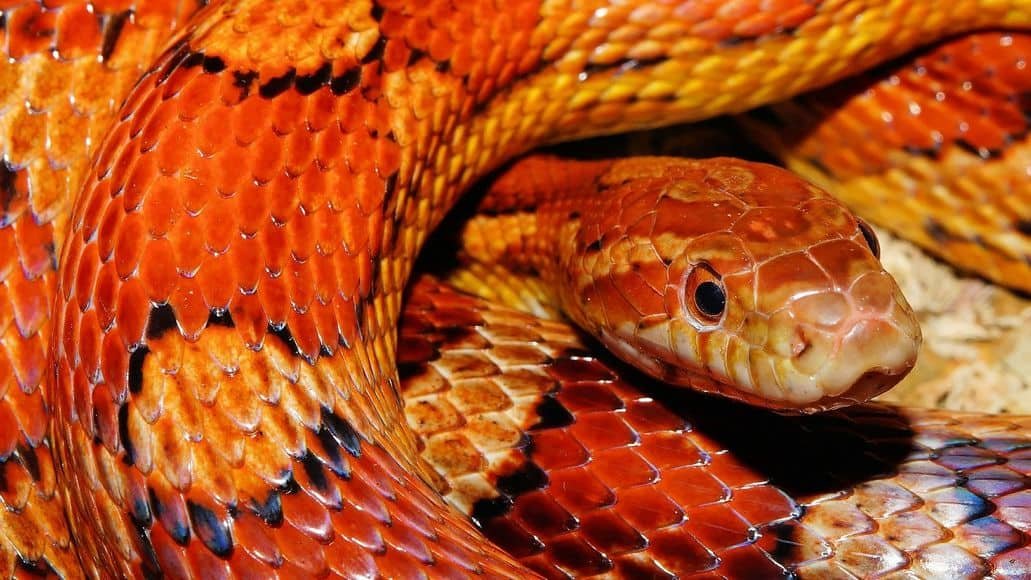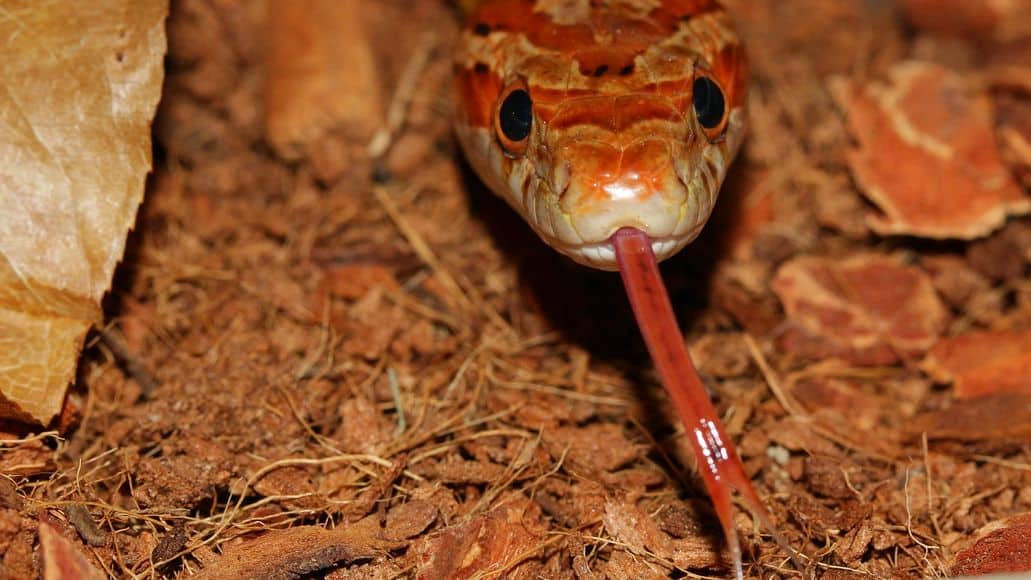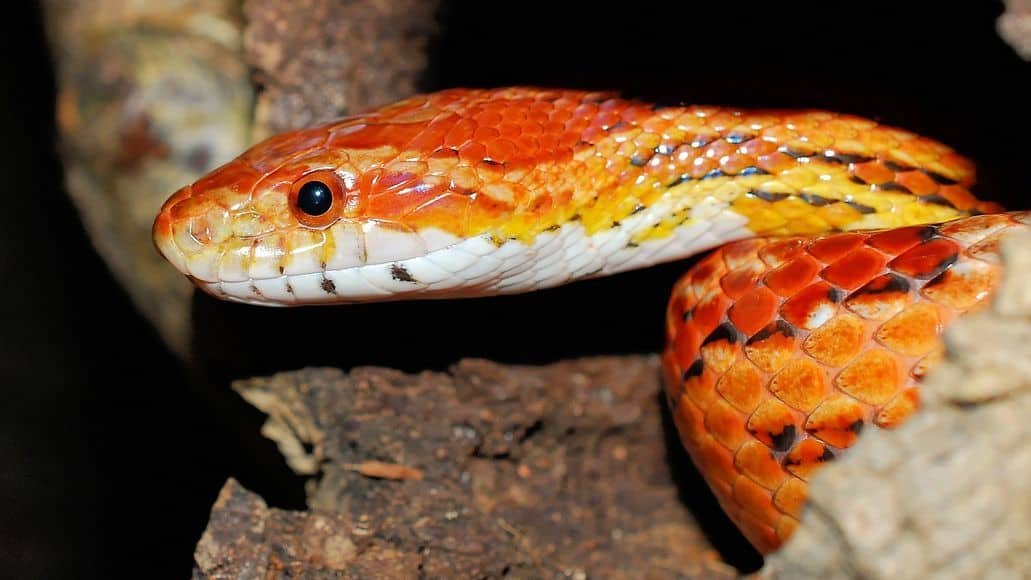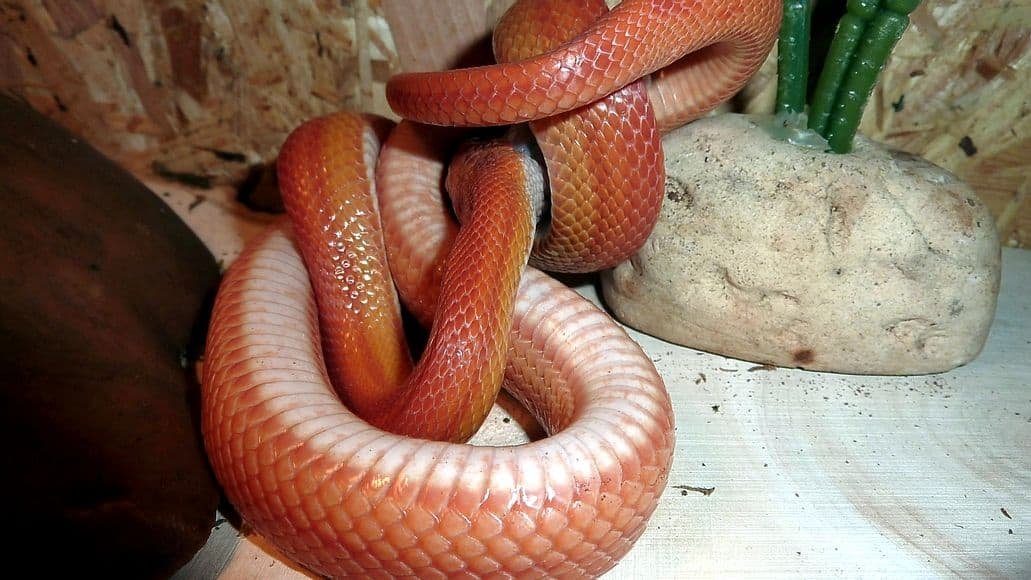
That’s because most snake owners don’t know the sex of their pet.
It’s not usually a big deal.
But it can be, if you plan on breeding your corn snake.
Whether you simply want to know the sex so you can pick out an appropriate snake name, or you need to know the sex for breeding, its not an easy thing to determine.
To be 100% sure about the sex, you may need to consult a veterinarian.
But there are some ways you can determine the sex of a snake at home, too. Let’s take a look.
Table of Contents
How To Sex A Corn Snake
There are three different do-it-yourself methods you can use to tell the gender of a corn snake. You can perform a visual inspection, probe, or pop the hemipenis.
Visually inspecting your snake’s tail is the easiest method and the only non-invasive one.
Probing and popping are techniques that should not be attempted by inexperienced snake owners. They could result in harm to your pet.
If you haven’t done these before, take your pet to a veterinarian or snake handler and have them show you what to do.
Even if you do know what you’re doing, popping and probing should not be done to a corn snake until they’ve reached sexual maturity, which takes around three years.

Let’s take a look at the most common sexing methods and how they work to determine the sex of your corn snake.
Examine The Tail
The easiest and best way to sex a corn snake is to examine the snake’s tail. Male corn snakes tend to have a thicker, longer tail than females.
The tapering is also different. It starts thick below the vent and ends in a thin tapered tip. Female tails stay thin and short and have an even taper below the cloacal vent.
Males also have a pair of hemipenes (two tubed sex organs) on the inside of their tail while females do not.
These hemipenes are below the cloaca, opening down either side of the tail’s midline and they cause large bulges on the tail. Other than the bulgy tail, these organs are not visible from the outside, unlike the male sex organs of mammals.
Probe

Another method of sexing a corn snake is probing. This requires inserting a slender metal rod into the snake’s cloacal vent (your snake may fart on you). You need specific probes, which you can purchase in a kit.
Using anything other than these specialized probes can be harmful. Before inserting, you should sanitize and lubricate your rod.
Do not use pressure to insert the rod down into the vent. If you have to apply pressure to make the tube go down, it means the snake is most likely a female and does not have hemipenes.
When the snake is male, the probe will go into one of the two hemipenes and down into the tail (nine to fifteen scales deep).
If you try to probe a female snake, the probe will stop shortly after inserting (one to three scales deep). There are small scent glands in the tail but not tubes for the probe to go down.
It’s important not to attempt this procedure unless you have experience. It is too easy to accidentally cause harm.
It would be best if you also had someone hold your snake still, because it needs to be awake for the procedure. It may try to bite them, but they are not venomous.
Pop The Hemipenes

Although “popping hemipenes” sounds painful, this technique is not harmful to your snake, if performed correctly.
However, you should not attempt this method if you are inexperienced. Instead, take your pet to a vet or experienced snake handler. They can demonstrate the process so you can try it on your own in the future.
To pop the hemipenes, you have to apply firm but gentle pressure with one finger to the vent. It’s best to do this with your thumb.
When appropriately performed on a male snake, the method will cause the hemipenes (the two snake penises) to pop out of the vent temporarily. These will look like two red tubes that come out on either side of the vent.
Unfortunately, this method only works on smaller snakes and is not effective at determining the sex of larger snakes. There is too much muscle around the vents to allow enough pressure to push the organs out.
This procedure is the least recommended method for sexing your snake due to the difficulty and potential for permanent harm. If you apply too much pressure, it could permanently relocate the sex tubes externally, which may require expensive surgery to fix.
Furthermore, if you fail to pop hemipenes out, it’s difficult to determine if it’s due to improper technique or because the snake is a female and not a male.
And sometimes, performing this procedure on a female snake can cause the scent glands to emerge from the vent.
Observe The Behavior

Although not as accurate as other methods, paying attention to your snake’s behavior can also help you determine its sex. Corn snake body language reveals a lot.
Male corn snakes are more active than female snakes. Males also will not eat during the breeding season. Examining your snake’s shed can help determine its gender, as well.
The shed skin of male corn snakes contains two dried pieces of skin located around the vent. These pieces are a sign of the snake’s hemipenes. However, if you only notice one small bump in the shed, it’s more likely a female skin.
Sexing Techniques Performed By A Vet

As mentioned, if you have no experience with the procedure of popping or probing, you should take your snake to a veterinarian or a handler experienced with reptiles.
But if you’re going to do that, there are other techniques the professionals can use that are actually more accurate.
Ultrasound
The most guaranteed way to sex your corn snake is to have your veterinarian perform an ultrasound.
Theoretically, you could purchase your own portable ultrasound machine to perform the tests yourself. But this only make sense if you are a snake breeder.
Even getting an ultrasound done by a vet is usually only something a breeder would do. Regular snake owners are unlikely to want to spend the money this procedure costs.
The cost of an ultrasound can vary by doctor and location. You should expect to pay anywhere from $200 up to $500, depending on if you use a general practice or specialty veterinarian.
X-Rays
X-rays must be taken by a licensed professional. This method is also a moderately effective way of determining your snake’s sex. But there are limitations, and there is no guarantee of accurately determining your snake’s gender.
This method is not one that most casual snake owners or professional breeders would use to determine their snake’s gender. Instead, you should only use this method if there are concerns about gender-specific health issues.
Sexing A Corn Snake: Final Thoughts
If you are trying to figure out the sex of your corn snake on your own, observing the size, shape and behavior is the best way to go about it. But obviously, with this method, you can never really be sure.
If you have experience, probing or popping are more accurate. But these procedures are best left to a veterinarian. If you have the money to spend and it is very important for you to be 100% sure about the sex, then you should spring for an ultrasound. Consider it part of the cost of owning a corn snake.
Leave a Reply